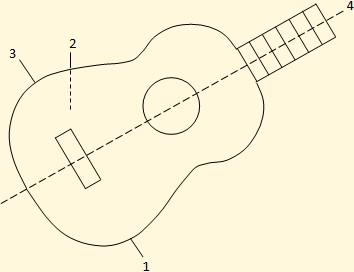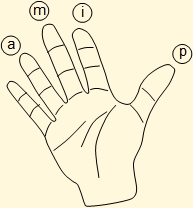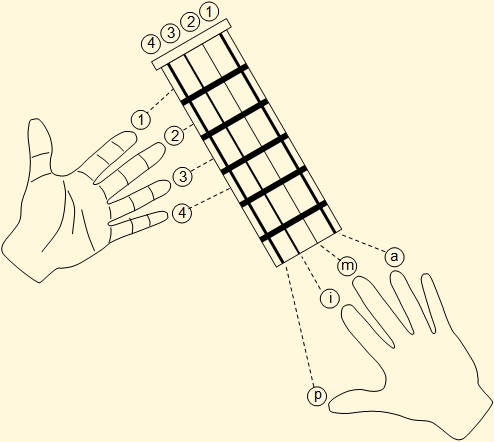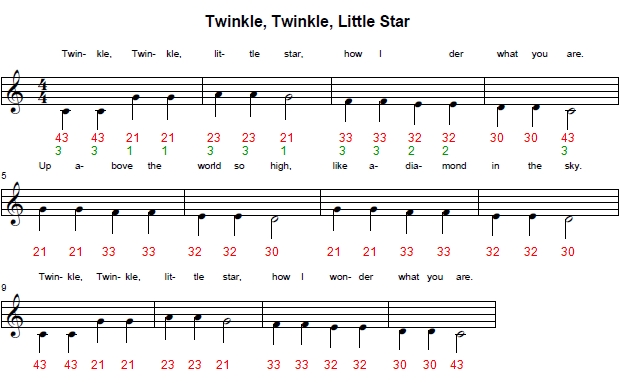
On the execution of the cuatro
Content
Position of the cuatro during executionUse of the left hand
Use of the right hand
Fingering and the cuatro fretboard
The following are general guidelines for the execution of the cuatro, which will be extended and refined throughout these pages.
Cuatro position during execution
There are many ways to hold the cuatro during its execution. The most comfortable positions are those in which the performer is sitting; however, sometimes you will have to run it standing up. For the beginner a sitting position is recommended in which the following indications are fulfilled:
- The lower part of the hoop should rest on the right leg.
- The bottom should rest on the upper abdomen.
- The forearm should rest on the upper edge of the hoop.
- The fretboard should be inclined oriented.

Use of the left hand
The left hand is in charge of holding the cuatro handle and creating the chords on the fretboard. On these pages the fingers of this hand are listed as follows:

It is not necessary to number the thumb since its only function is to serve as a support to the neck of the cuatroin conjunction with the other fingers, in charge of digitizing the chords. To do so, it must be supported on the back of the neck, opposed to fingers 1 to 4.
When forming the chords fingers 1 to 4 will press the strings in the spaces between the frets, closer to the lower fret than the upper fret, but never on it. The fingers should be arched, so as to exert pressure on the strings with the fingertips, therefore a low cut of the nails of the left hand is recommended. When stepping on a string, avoid touching adjacent strings, as this would distort the sound to be produced.
Fingers not used in the fingering of a chord should remain close to the fingerboard, ready for use if required in the production of the next chord.
At the beginning of the study of the cuatro the fingertips may be too soft, which will make it difficult to produce a clear sound; however, after a short time of practice they will harden and form calluses, which will improve the cleanliness of the sound produced.
Use of the right hand
The right hand is in charge of making the strings vibrate, by means of strumming or pulsations. In this these pages the fingers of this hand are identified as follows:

The right hand is usually held close to the mouth of the instrument. Positions closer to the fingerboard produce softer sounds, and positions closer to the bridge produce louder sounds.
The fingers of the right hand should be kept relaxed and slightly bent so that the strings can be strumed or plucked with the fingernails. Although short nails can produce a satisfactory sound, letting them grow a little can help to obtain a brighter sound; the performer should experiment to adopt the length that pleases him the most, not only from the point of view of sound, but also from the point of view of hygiene and aesthetics.
The position adopted by the fingers of the right hand depends on the technique used, strumming or fingerpicking. Moreover, in the strumming its position depends on the rhythm to execute and the tempo used, so it can vary in the execution of the same melody. Practice and experience will indicate to the performer the adequate posture to a melody and to the style of execution that he has developed.
Fingering and the cuatro fretboard
When playing the cuatro you will have to decide how you will use the fingers of the left hand to digitize chords, and execute scales and melodies, and the fingers of the right hand to press the strings in the execution of arpeggios (notes of chords played is sequence and not strummed), scales and melodies. To a large extent this use is imposed by the arrangement of the four strings and frets on the fretboard of the cuatro, so that there is a natural correspondence between the frets and fingers index to pinky of the left hand, and the strings and fingers thumb to ring of the right hand, as shown below:

Next an exercise is proposed that will allow you to practice the use of the fingers of the left hand in the fingering of an very simple melody. The use of the right hand is limited to the use of the fingertip to pluck the strings down.

Below the notes, the numbers indicating the string and fret have been inserted in red, and the numbers indicating the fingers of the left hand have been inserted in green. Observe the natural correspondence between fingers and frets.
If you are not yet familiar with this melody, click on the following link:
The following video will allow you to see the fingering of this melody on the fretboard of the cuatro. The program CuatroVe has been used, which is described on the Software page:
NOTE: It is recommended to use VLC for the playback of this and other videos contained in these pages, as it allows you to control the playback speed.
Various